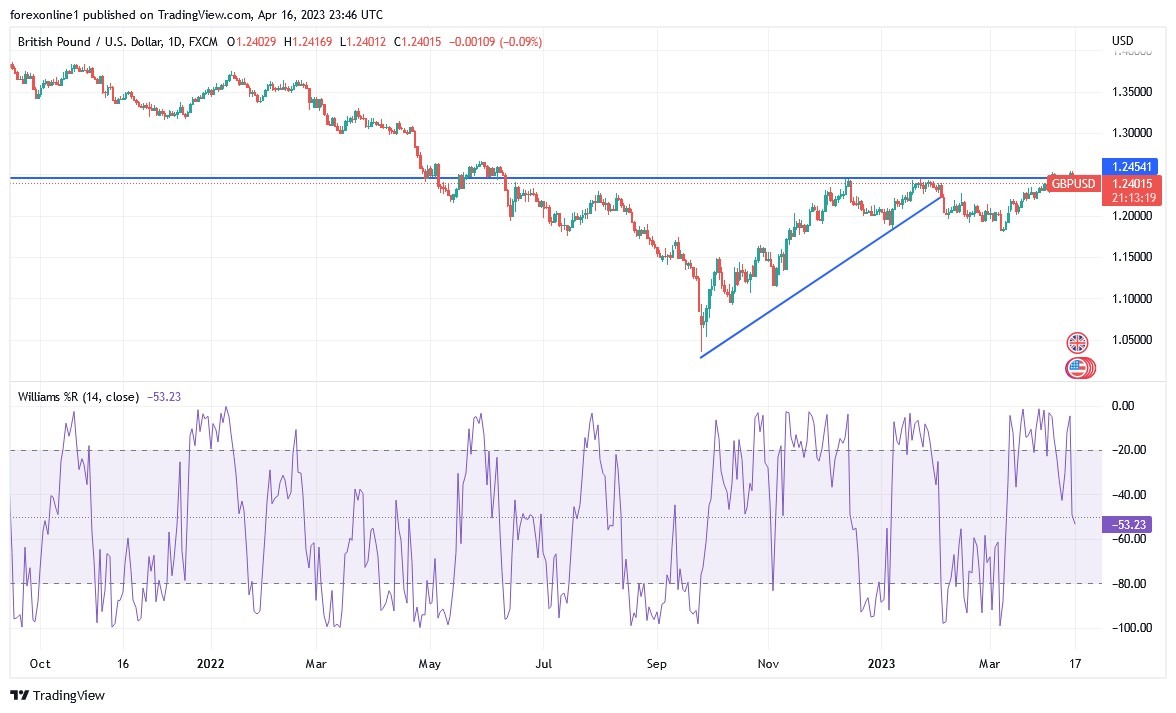At the end of last week’s trading, the price of the GBP/USD currency pair was subjected to selling operations that pushed it towards the 1.2399 support level. This is after it tested in the same week the 1.2546 resistance level, the highest for the currency pair since June 2022. Its gains came primarily amid pressure on the US dollar, amid calming expectations about the future of raising US interest rates, after the announcement of US inflation figures and the content of the minutes of the last meeting of the US Federal Reserve.
Meanwhile, the Bank of England's latest forecast indicates that inflation is likely to drop sharply from 10.4% in February to around 4% by the end of the year before then falling below the 2% target. By the end of 2024, and even if the bank rate remains unchanged at the recently raised 4.25% level in the meantime.
This could mean that the Bank of England will be reluctant to raise interest rates further in May and subsequent months, which poses risks for the British pound.
Economic Outlook
The GBP/USD is trading affected by the results of the latest economic data, as the British GDP for February missed the expected (MoM) change by 0.1% with a change of 0%. Industrial production in the UK for the period also fell less than the expected change (MoM) by 0.2% with a change of -0.2%, while Industrial Production declined by 0.2% with a change of 0% (MoM). The equivalent (YoY) beat the estimated change of -4.7% with a change of -2.4%.
In the US, Initial Jobless Claims for the week ending April 7th missed the expected claims number of 232K with a slight increase of 239K. On the other hand, prior period continuing claims beat expectations at 1.814 million claims with an overall decrease of 1.81 million, while the PPI excluding food and energy matched expectations (yoy) at 3.4%.
Earlier last week, the US CPI excluding food and energy also matched both (MoM) and (YoY) forecasts at 0.4% and 5.6%, respectively.
In general, the British pound rose above the 1.25 resistance against the dollar in the wake of economic growth data in Britain, which confirmed that the British economy is ready to avoid recession in the first half of 2023, despite the impact of public sector strikes. UK GDP was flat in February, disappointing expectations for the economy to grow by 0.1% as public sector workers cut back on tools, the Office for National Statistics said.
However, the disappointment was mitigated by the news, as January growth estimates were revised by the Office for National Statistics to show growth of 0.4%, and it is now clear that the UK economy will grow in the first quarter of the year. This provides a positive economic surprise for the forex markets. The pound-to-euro exchange rate was higher following the figures at 1.1370, and the GBP/USD was above the 1.25 barrier at 1.2516.
In the three months to February, the British economy grew by 0.1%, beating estimates of no growth at all. The pound sterling is the best performing major currency in 2023 thanks to a series of better-than-expected economic data results.
Technical analysis of the GBP/USD pair today:
- On the near term, it appears that the GBP/USD is trading within a bullish channel formation.
- This indicates a significant short-term bullish bias in market sentiment.
- Therefore, the bulls are looking to extend the current rally towards 1.2538 or higher to the 1.2555 resistance.
- On the other hand, the bears will be looking to pounce on pullbacks around 1.2508 or below at 1.2493 support.
On the long run, and according to the performance on the daily chart, it appears that the GBP/USD is trading within a sharp bullish channel formation. This indicates a strong long-term bullish bias in market sentiment. Therefore, the bulls will target extended gains around 1.2595 or higher at the resistance 1.2681. On the other hand, the bears will be looking to pounce on pullbacks around 1.2431 or below at 1.2347 support.
Ready to trade our Forex daily analysis and predictions? Here are the best Forex brokers in the UK to choose from.


